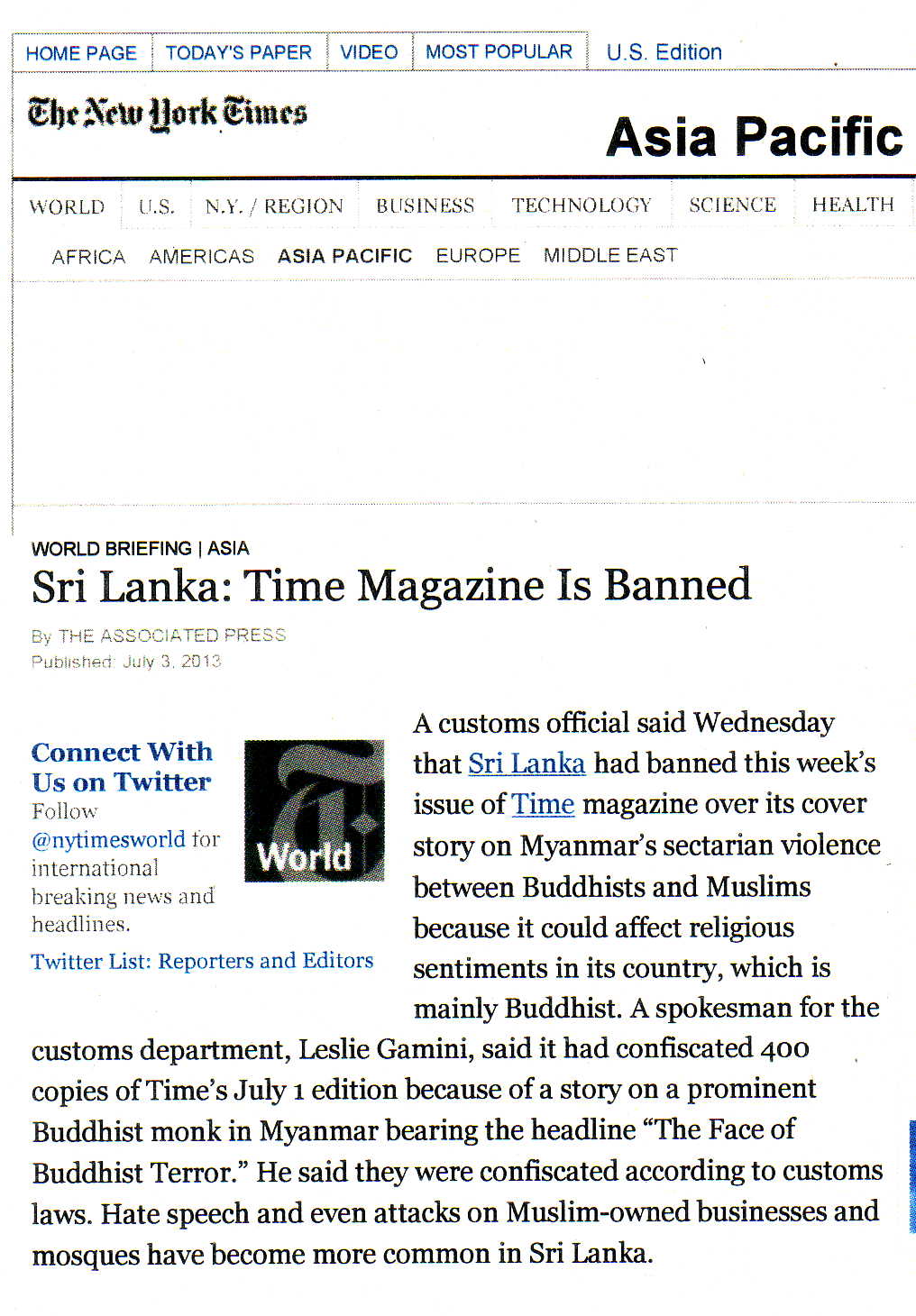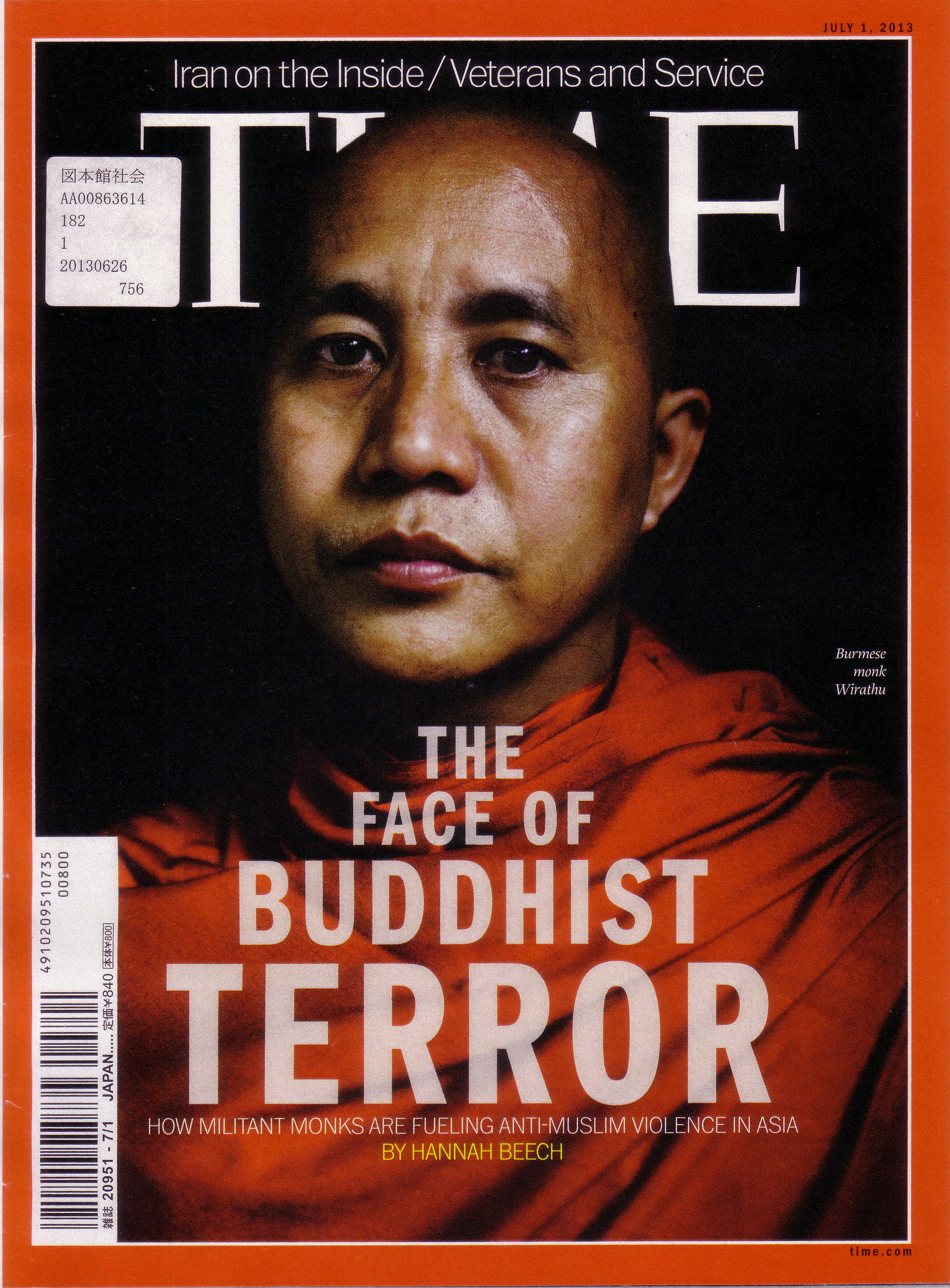by Sachi Sri Kantha, July 26, 2013
 According to a recent Associated Press news brief, Sri Lanka’s Customs confiscated 400 copies the July 1st issue of Time magazine. The reason cited by Mr. Leslie Gamini, a spokesman for the Customs Department, the cover story entitled ‘The Face of Buddhist Terror’ “could affect religious sentiments in its country, which is mainly Buddhist.”
According to a recent Associated Press news brief, Sri Lanka’s Customs confiscated 400 copies the July 1st issue of Time magazine. The reason cited by Mr. Leslie Gamini, a spokesman for the Customs Department, the cover story entitled ‘The Face of Buddhist Terror’ “could affect religious sentiments in its country, which is mainly Buddhist.”
So as not to deprive the freedom of knowledge enshrined in the Sri Lankan Constitution, for the Sri Lankan readers of Time magazine, I opted to deliver the contents of the cover story in this banned issue. The cover story predominantly features the terrorist activities of Buddhist monks in Myanmar and Thailand.
Sri Lankan Buddhist monks are covered only in two paragraphs under the sub-heading ‘Temple and State’, with focus on recently formed Bodu Bala Sena (BBS). Two direct quotes cited in these include one from the general secretary of BBS, Ven. Galaboda Aththe Gnanasara Thero, and the other one from a military guy Gotabhaya Rajapaksa, the Presidential sibling and the patron of a handful of Tamil traitors. For the record, I present below the sentences of these two paragraphs in entirety.
“Dreams of repelling Islam and ensuring the dominance of Buddhism animate the Bodu Bala Sena (BBS), Sri Lanka’s most powerful Buddhist organization whose name means Buddhist Strength Army. At the group’s annual convention in February in a suburb of Sri Lanka’s capital Colombo, more than 100 monks led the proceedings, as followers clutched Buddhist flags, clasped their right hand to their chest and pledged to defend their religion. Founded just a year ago, the BBS insists that Sri Lanka, the world’s oldest continually Buddhist nation, needs to robustly reclaim its spiritual roots. It wants monks to teach history in government schools and has called for religious headscarves to be banned, even though 9% of the population is Muslim. Said BBS general secretary and monk Galaboda Aththe Gnanasara Thero at the group’s annual meeting: ‘This is a Buddhist government. This is a Buddhist country’.
Hard-line monks, like those in the BBS, have turned on minority Muslims and Christians, especially since the 26-year war against the largely Hindu Liberation Tigers of Tamil Eelam insurgency ended four years ago. After President Mahinda Rajapaksa, a conservative, was elected in 2005, Buddhist supremacist groups became more powerful. In recent months, their campaign of intimidation has included attacks on a Muslim-owned clothing store, a Christian pastor’s house and a Muslim-linked slaughterhouse. Despite monks’ being captured on video leading some of the marauding, none have been charged. Indeed, temple and state are growing ever closer in Sri Lanka, with a monk-dominated party serving as a coalition member of the government. In March, the guest of honor at the opening ceremony for the BBS-founded Buddhist Leadership Academy was Sri Lanka’s Defense Secretary Gotabhaya Rajapaksa, the President’s brother, who said, ‘It is the monks who protect our country, religion and race.’ ”
It is my impression that Hannah Beech, the author of this cover story, had not visited Sri Lanka. None of the five photographs presented in the cover story are related to any recent incidents that had happened in Sri Lanka. As indicated, under her byline, she had been to Meikhtila (Myanmar) and Pattani (Thailand). She had also omitted the self-immolation death of Buddhist monk, Bowatte Indarathana that happened in May of this year. This was a first in Sri Lanka. Ven. Indarathana was protesting “against the slaughter of cattle and the alleged conversion of Buddhists by the country’s minority faiths”, according to BBC’s news report of May 26, 2013.
One finds it hard to believe why the Sri Lankan Customs had to stop this particular Time issue. But who can vouch for absence of sycophantic behavior among the Sri Lankan Custom Officials? Visiting Sri Lankan politicians and ambassadors never fail to identify the similarity of Buddhism between Sri Lanka and Japan, whenever they have an opportunity to speak. But, Japan didn’t ban this particular Time issue for its contents. Here lies the essential variance between the terrorist Buddhism of Sri Lanka and tolerance Buddhism of Japan.
The recent issue of Time magazine (July 29, 2013) carried four letters from the readers on the July 1st cover story. Among these, two relate to the Sri Lankan brand of Theravada Buddhism. One reader, identified as Naraayanie Sri Raviculan (from Shizuoka, Japan) had written,
“The article did a fine job of highlighting what’s already been in the news recently, but it said nothing about the history of Buddhist fundamentalism. It’s not a new thing. Beech spoke of the Bodu Bala Sena that formed in Sri Lanka less than a year ago, but it is worth pointing out that ethnic Sri Lankan Tamils have been aware of hate-inciting Buddhist monks for decades. While the world holds to its idealistic illusions about the one major religion that appears to be free from the violent and toxic fundamentalism that seems to afflict all the rest, Buddhist extremism was there, alive and well, free to fester and gain momentum for decades.”
Another reader identified as Ravi Nair (from Chennai, India) had commented, “I am not suggesting everything is fine with Buddhist practices, but one cannot deny that they have been most compassionate, rational and liberal. You will have to scrape the bottom of history’s barrel to dig out a Buddhist atrocity on a mass scale. What happened in Sri Lanka was ethnic cleansing and not religious.”
In my view, I’m not sure whether Ravi Nair’s letter was published in entirety or it was edited for clarity. It appears to me that his knowledge on Sri Lankan affairs is rather incomplete.

Time magazine has thought it is time to expose the religious extremism that had now come to dominate Theravada Budhism.
Dr Sachi’s comparison with the Budhism is noted. It should also be noted that Dalai Lama has also condemned the Buddhist religious extremism violence.
The Budhism practiced by Japan and Tibet are based on Mahayana sect. The Sri Lankan and Burmese variety is Thervada.
From the happenings in Sri Lanka and Burma one is forced to conclude that Mahayana Budhists are the true followers of The teaching of Budha.
It is interesting that Therevada sect has been the only sect to cause such fundamental extremism under the name of “Buddhism”. From Sri Lanka, Myanmar, and even Cambodia and Thailand, Theravada is practiced and those countries have been absorbed into Buddhist violence. Mahayana though is not closer to the original primordial teachings of the Buddha, but Theravada is the oldest and closest to original teachings. I think it has to do with the fact that under Theravada, doctrine is supremely upheld and respected, because it is believed to be by followers “exactly what the Buddha has practiced and preached”. So there is a form of puritanical influence and strict and rigorous conservatism associated with the sect and an almost fervent religious fundamentalism to preach and practice exactly what is in the doctrine and interpret it as exactly. Mahayana developed as a divergent school, but some say that it has connections with early Buddhism, but cannot be solely proved. Mahayana is the school that developed extensively in South India and some parts of the North, and spread to East Asia through Indian monks such as the famous Bodhi Dharma, who helped establish the Zen school of Buddhism. Mahayana is the largest school of Buddhism as well and is what the West and other countries around the world commonly practice and learn about as opposed to Theravada. The positiveness of Buddhism can be associated with Mahayana than Theravada and owes to its “clean” image. Mahayana is also more inclusive and preaches that anyone can become a “buddha” and attain enlightenment, whereas Theravada maintains a strict hierarchy of the sangha (the monks) and the lay people who do not renounce their lives, and only the monks can attain true nirvana, and achieve it through the help of the laypeople, who cannot attain nirvana because they are not monks and their “duties” include helping the monks and knowing and understanding the doctrine to lead their lives. Doctrine is not emphasized in Mahayana traditions and serves to mostly guide while the adherent mostly finds enlightenment on their own with guidance from teachers and fellow adherents, like in Zen. From that, Theravada is more prone to fundamentalism through that emphasis and hierarchy it seems.
The original teachings of the Buddha cannot be said to be the best teachings. The teachings in today’s Theravada is the closest to what early Buddhism that the Buddha spread himself would have been like and even then this school has been a result from divergences encountered during Buddhist councils and enormous disagreements on doctrine and pragmatic practices among monks. The councils serve to acknowledge that the very institutionalizing of Buddhism led to its drastic changes and the “real” way is long gone due to the almost political treatment of it during those times to find meaning to different people. People have interpreted it differently for many centuries, so what is called “Buddhism” can only be attributed to what people have overwhelmingly practiced than the actual pillars of the Buddha. We may never know what Buddhism was actually like. Theravada which was established long after the Buddha’s death is the only sect considered “close” to the original, but even it has been established so long after and contains many derived scriptures. One example is the treatment of women and monks who are female. There is scripture entailing that women are inferior and they cannot attain enlightenment, but more historical research has concluded that it was probably not preached by the Buddha himself and that some monk managed to put his own personal discrimination of womenfolk into the Buddhist literature as scripture by the Buddha. So we can only assume that most of this doctrine is not in fact original and is derived. Also noting that the written scriptures came into existence after writing was introduced to India, which was thousands of years after the Buddha, which before, monks used to recite and pass from memory his “teachings”.